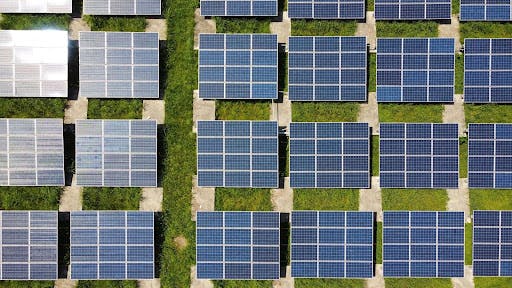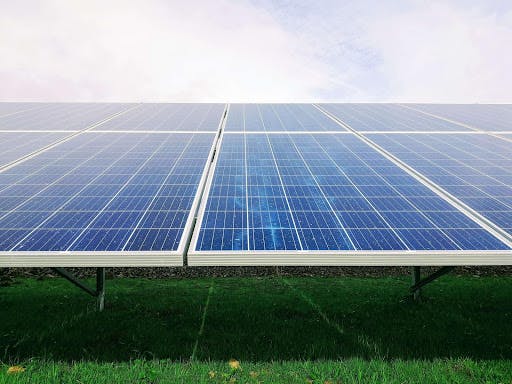A Detailed Guide To The Solar Project Development Process
11 May 2023

As the world continues its journey to net zero, solar energy continues to be a key weapon in the renewable energy development arsenal.
Global backing of renewable energy development shows no sign of slowing down – due to a variety of factors including global warming and energy security – with continued investment from governments and private industry in renewables technology.
As the cleanest and most abundant renewable energy resource available currently, solar energy production provides a fantastic investment opportunity for those looking to diversify their infrastructure portfolios.
In this guide, we will take a comprehensive look at the solar project development process, from initial assessments and design to, regulatory requirements, financing options, construction, and ongoing maintenance.
Preliminary Assessments
The first step when developing a utility-scale solar farm is to conduct preliminary assessments.
These assessments involve identifying the optimal site for the project and assessing various factors that affect the project's feasibility.
Site Selection
Site selection is crucial in the development of any utility-scale solar project. When scouting for a suitable site, it’s important to remember:
- An ideal site should have an abundance of solar radiation, meaning it receives ample sunlight throughout the day
- The site should be easily accessible for construction equipment and have suitable terrain for the solar panels and other equipment
- The topography of the land should be flat, with no trees, and not on a flood plain (to avoid damaging equipment)
- Soil conditions should be good as this may impact structural design or affect construction costs
- Should be accessible to the grid or, have potential access (although there are examples of ‘off-grid’ solar farms that depend on sophisticated battery storage systems)
- Should not be in proximity to threatened ecosystems or protected heritage or cultural sites
Feasibility Study
Feasibility studies are needed to evaluate the site's economic viability, including a high-level economic analysis of the site. These studies generally include:
- Financial analysis: The financial analysis of the site includes evaluating the costs and benefits of the project to determine its economic feasibility
- Technical analysis: A technical analysis is conducted to evaluate the site's technical feasibility, including the electrical infrastructure, soil conditions, and topography
- Environmental impact assessment: this stage looks to identify any potentially damaging effects on local ecosystems and wildlife
Market Research
Market research is conducted to gain a thorough understanding of local regulations and incentives, identify competition, gauge market demand, and assess grid connection possibilities.
Local regulations and incentives must be evaluated to determine the site's eligibility for permits and incentives.
Design and Engineering
Once preliminary steps including site selection and solar resource assessment have been carried out, system design and engineering can begin. This phase involves developing a plan that takes into account the site's physical and technical characteristics. Let’s take a look below.
Component Selection
The solar project's design must take into account the type of components used, including solar panels, inverters, and mounting and tracking systems. The selection of components is based on operational and budgetary requirements.
Solar Panel Orientation and Tilt
The solar panel's orientation and tilt are critical factors in optimizing the system's energy production. The optimal orientation and tilt of the panels are determined by considering the site's conditions, including latitude, climate, and shading.
Electrical and Structural Design
The electrical and structural design of the solar project involves planning the electrical layout and plant sizing, including grid connection and integration.
The design should take into account solar power quality considerations, such as harmonics and power factors, to ensure that the system meets grid interconnection requirements. The structural design should consider the wind and snow loads on the solar panels and other equipment.
Permits and Approvals
A series of permits and approvals must be obtained to progress with a utility-scale solar project. The local authorizations required typically include zoning approvals and land use permits.
Environmental Permits
The location of a proposed solar project will determine how difficult it will be to attain a valid environmental permit with different countries having different regulations in place.
It’s important for developers to determine – as early as possible – whether they will be required to obtain such permits. This information should be available on local authority websites.
Figuring out whether or not you’ll require a permit means conducting an environmental impact assessment (EIA) which will evaluate the effects of the project on the surrounding wildlife and habitats – in some cases, a wildlife and habitat protection plan may need to be developed.
Grid Connection & Interconnection Agreements
The grid connection and interconnection agreements are essential components of the solar project development process.
Utility coordination and technical requirements must be thoroughly understood to ensure that the project is compliant with the relevant regulations. Communication with utility companies should be started as soon as possible and finalised before construction begins.

Financing and Procurement
There are several viable solar financing options open to developers, that we have included below.
Before we go into these options, it’s important that we first cover PPAs and their role in helping solar project developers to unlock funding options.
Power Purchase Agreements (PPAs)
PPAs are long-term agreements between the developer and an energy buyer, such as a private company or government entity.
These agreements involve the purchase of electricity generated at a fixed rate (often longer contracts of 10+ years). The more secure the agreement is, the greater the access to borrowing options.
An example of this is Transport for London’s tender looking to secure a 15-year PPA agreement with a renewable energy developer.
Securing a predictable source of revenue through a PPA will make it easier for developers to secure additional funding options.
Bank Loans / Debt Financing
Debt financing is a popular option to fund a project, with lenders providing up to 80% of the capital. However, lenders are exposed to the entire downside of the project, making it crucial to understand how they perceive the risks involved.
Traditional debt metrics, such as repayment history and cash flow available for debt service, are typically used when the borrower is liable for repayments and has a prior history that can be assessed.
But for new developers, borrowing large tranches of debt to finance projects can be challenging without a track record or the desire to be held liable for large repayments.
Equity Financing
For large-scale utility projects, equity financing may still be necessary even if the majority of the capital is funded by debt. The remaining 20-40% is typically filled through equity or shareholder loans.
Equity financing can come from the corporate owner or external sources, where a portion of the equity is issued in exchange for funding. Unlike loans, equity investors don't require repayment but receive a share of the project's profits over time.
While project owners maintain control, they give up a portion of ownership, allowing investors to benefit from any significant profits. This risk-reward incentive can encourage investors to take on the larger risks associated with early-stage renewable projects.
Project Financing
Project finance can revolutionise the development process for developers by isolating risks, unlocking higher borrowing potential, and speeding up the development process.
In essence, project finance involves placing the project in a Special Purpose Vehicle (SPV), where loan repayments are made solely from cash flows generated by the project. With simple solar project financing, the revenue risks are primarily off-taker/counterparty risks, reducing the chances of corporate activities introducing unpredictable complexities to calculations.
Additionally, the non-recourse structure generally associated with project finance means that the collateral is limited to SPV assets, reducing risks to the corporate owner's other balance sheet items.
Government Incentives and Grants
Developers should be aware of the government incentives and grants they are entitled to.
Depending on your location, regional authorities may have renewable energy targets that they need to hit and may have tax credits or rebate schemes in place. If available, this will contribute towards cost savings for the project.
Procurement Process
Compiling a request for proposals is where this stage starts. An RPF is a formal bid document that outlines the PV requirements to service providers such as solar installation services, as well as the contract terms and the bidding process.
This can be a lengthy process taking anywhere from a few months to a year, involving a number of different parties from project leaders to lawyers, energy managers to site managers.
After the RFP has been administered, proposal meetings and site tours can be made. Well-defined criteria should be evaluated before supplier and contractor selections are made and contract negotiations are entered into.

Construction and Installation
With permits and financing secured, the construction and installation phase of a solar project can commence.
This phase is where the physical solar panels and equipment are installed on-site and connected to the power grid. It includes several key steps that require careful planning and execution.
Site Preparation
The first step in the construction phase is site preparation. This involves clearing the land of any vegetation, debris, and other obstructions that could hinder construction work. It also includes performing geotechnical assessments to evaluate the site's soil and terrain conditions. These assessments help ensure that the site is stable and suitable for the installation of solar panels.
Component Installation
Once the site is cleared and prepared, critical infrastructure can be installed including solar panels, inverters, mounting systems, and other necessary components.
Solar panel installation requires careful planning and execution to ensure they are installed safely and effectively.
The numerous mounting systems will be installed on the ground or on a roof, depending on the design of the solar project.
The inverters are where the magic happens, converting DC electricity produced by the solar panels into consumable AC electricity that is then channelled into the grid.
Electrical Connections
So you've installed the solar panels and inverters, Now what? it's time to connect them to the grid. To do this, DC cables from the panels are connected to the inverters, which are then linked to the grid using AC cables.
Transformers are installed to step up the voltage of the AC electricity produced by the inverters to match the voltage of the grid.
Quality Control and Inspections
Once the above steps have been completed it's time to inspect the setup, completing a number of quality control measures to ensure everything is working correctly. These measures include safety compliance, final inspections, and system performance testing.
System Performance Testing
System performance testing involves checking the output of the solar panels and verifying that the system is operating as intended.
These tests include confirmation of voltage levels and current output of the solar panels and inverters, and checking the performance of the monitoring and control systems.
Safety Compliance
Safety compliance is also a crucial element of the construction and installation phase. This includes using protective gear, working with appropriate tools, and following safety guidelines and procedures.
Final Inspections
A final inspection is carried out to ensure that the solar project is installed according to the required standards and regulations.
This inspection is performed by a qualified inspector who signs off on the installation, ensuring that it is safe and performs as expected.
Once the installation has passed the inspection, it is connected to the grid and is now operational.
Operation and Maintenance
Once the solar project has been installed, it's important to maintain it ensuring continued performance and longevity. The operation & maintenance (O&M) phase is a critical stage of the project lifecycle that ensures the system operates as efficiently as possible throughout its lifespan.
Monitoring System Performance
To maintain peak performance, it is crucial to monitor system performance namely, monitoring the energy output of the solar panels and the performance of the inverters.
Remote monitoring systems and performance data analysis can be used to identify any issues or defects with components. Analysing performance data helps to identify areas where improvements can be made to increase efficiency.
Preventive Maintenance
Preventive maintenance is an essential part of O&M. Regular maintenance checks, including automated monitoring and servicing, can help to maximise efficiency, reduce downtime, meet regulatory requirements and extend the lifespan of equipment.
This can include checking for loose connections, inspecting cables and wiring, and cleaning the solar panels.
Reactive Maintenance and Repairs
Despite regular preventive maintenance, unexpected issues can still arise that require reactive maintenance and repairs.
Automated monitoring can provide troubleshooting and diagnostics that alert a project team of any malfunctions or inconsistencies. Plans should be in place for scenarios that demand reactive maintenance and repairs, and component replacements should be ready on-site to expedite repairs in the event of a component failure.
PF Nexus
PF Nexus is transforming the landscape of renewable energy investing by providing a comprehensive solution for global connectivity and visibility. The platform serves as a centralised hub for development and finance teams to identify, research, and explore renewable energy investment opportunities.
Subscribers gain access to an ecosystem database and project marketplace, where they can evaluate deals and collaborate with transaction advisors and project owners in the renewable sector. The platform supports various renewable projects, such as utility-scale solar, wind, battery, and other sustainable infrastructure, to ensure a diverse investment portfolio.
With more than 4,500 users from over 2,500 clean energy investors, lenders, advisors, and developers, PF Nexus is rapidly gaining traction in the industry, particularly as countries strive towards Net Zero emissions, and the energy transition continues to progress.
Conclusion
There you have it, a guide to the solar project development process. While the development process can be complex, involving various assessments, design and engineering, permitting and financing, construction, and ongoing maintenance, the benefits of these projects are numerous.
To find out more about how PF Nexus can help bring your solar development project to life, get in touch today.